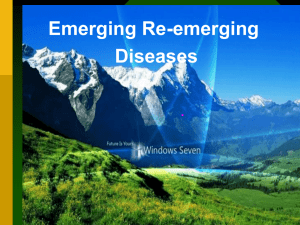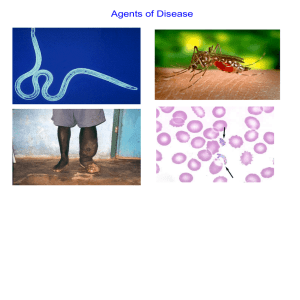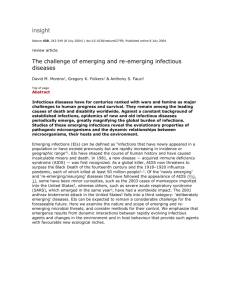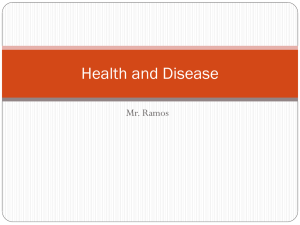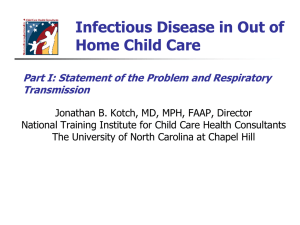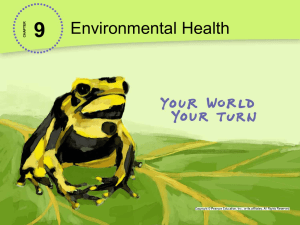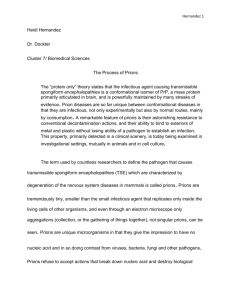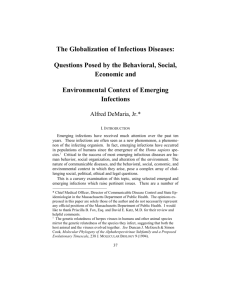chapter 8 emerging and re-emerging infectious diseases
advertisement
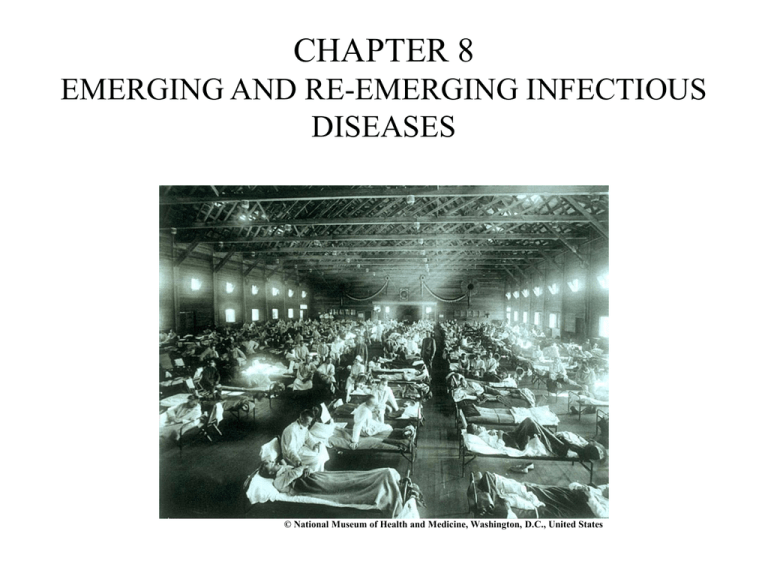
CHAPTER 8 EMERGING AND RE-EMERGING INFECTIOUS DISEASES © National Museum of Health and Medicine, Washington, D.C., United States WHY IS THIS IMPORTANT? • The world is facing challenges from both new diseases and re-emerging ones. • Understanding how once dormant diseases are now re-emerging is critical to controlling the damage such diseases can cause. OVERVIEW GIROLAMO FRASCATORO Speaking About Syphilis • “There will come yet other new and unusual ailments in the course of time. And this disease will pass away, but it later will be born again and be seen by our descendants.” • This quote was written 450 years ago. INFECTIOUS DISEASE • Infectious disease has played a prominent role in world history. – The Black Death in the Middle Ages killed 1/3 Europe’s population. – Measles destroyed the South American Aztec civilization. – Smallpox destroyed indigenous peoples of North and South America, facilitating the conquest of the New World. "Triumph of Death" (Black Plague) Painted in 1562 Advances of the 20th Century •December 1967, Surgeon General William H. Stewart declared victory over infectious diseases. •Citing benefits of antibiotics and vaccines Proportions of major causes of death in Chile • EMERGING INFECTIOUS Emerging infectiousDISEASES diseases are those whose incidence has increased over the past 30 years. – Some are diseases that have never been seen before. – Some were previously documented but without a known etiology. • More than 30 new diseases have been identified in the past 30 years, including: RE-EMERGING INFECTIOUS DISEASE • Some diseases are re-emerging after being dormant for more than one hundred years. – Tuberculosis – Cholera CDC: 2010 TB rates per state (per 100,000 population) RE-EMERGING INFECTIOUS DISEASE • Many of these diseases were thought to be controlled through antibiotics. – In some cases the re-emerging disease is resistant to antibiotics. Reported prevalence of XDR-TB among MDR-TB cases, 2002-2007 World Health Organization TUBERCULOSIS (TB) • An estimated 2 billion people worldwide are infected with tuberculosis. • Mycobacterium tuberculosis is the causative agent for TB. • Each year eight million people worldwide are infected with TB. • It is estimated that 2 million deaths occur worldwide per year. TUBERCULOSIS (TB) • TB is still the leading killer of young adults worldwide. • Minority populations in the US are affected disproportionately by TB. – It is nine times more frequent among foreign-born individuals living in the US than in native- born people. TUBERCULOSIS (TB) • Antibiotics developed in the 1950s slowed the spread of TB, but by the year 2000, the incidence began to rise. • Possible causes of the increase in TB: – – – – HIV/AIDS epidemic Increased poverty, IV drug abuse, and homelessness Increased immigration of infected individuals Increased elderly population, especially those in long term care facilities – Failure of patients to complete antibiotic treatments. •In recent years, falling living standards and decline of infrastructure in some countries has aided the re-emergence of some infectious diseases. RE-EMERGING INFECTIOUS DISEASES EMERGING INFECTIOUS DISEASES • 25-35% of the 60 million deaths worldwide that occur each year are due to infectious disease. • Four historical patterns of transition have been identified in emerging diseases. • All four transition mechanisms contribute to rapid spread of emerging and re-emerging diseases. EMERGING INFECTIOUS DISEASES • First transition (also referred to as crowd transition) – Occurs when people begin to live in much closer proximity to one another – Higher population density – Proximity between populations allows for easy transmission of disease Sir John Harington Knighted in 1596 EMERGING INFECTIOUS DISEASES • Second transition – Neighboring civilizations made contact with each other through war or trade – Contact allowed the exchange of pools of infectious organisms and vectors between populations. EMERGING INFECTIOUS DISEASES • Third transition – Worldwide exploration and colonization led to the identification of new populations – Newly identified populations came into contact with pathogens never seen before within their cultures. – Immunologically naïve and susceptible populations. • EMERGING INFECTIOUS Fourth transition – this DISEASES is happening today. The ongoing causes are: – Globalization – – – – – – – – – – Global urbanization Increase in population density Poverty Social upheaval Travel New behaviours (medical / sexual tourism) Long distance trade Technology development Land clearance Weather / Climate Geographical Distribution of West Nile Virus Origin: Uganda Global Distribution of Cholera Origin: India ENVIRONMENT AND ID • Humans continue to encroach on uncultivated environments. • Creates an increased risk of contact with new pathogens. • Examples of diseases encountered as a result of this encroachment are: Aedes aegypti – Hanta virus mosquito – Dengue fever FOOD-BOURNE INFECTION VECTORS • As populations grow, there is an increased pressure to produce more meat. • This has led to the emergence and spread of infections from farm animals to humans – Salmonella species – “Mad cow” disease – E. coli O157:H7 GLOBALIZATION AND TRANSMISSION • Genetic changes in pathogens can occur through a process known as re-assortment. – An example of this is avian influenza. • Modern air travel disperses pathogens worldwide very rapidly. • Increasing numbers of immunocompromised hosts presents an increasing number of susceptible targets. HURDLES TO INTERSPECIES TRANSFER • A pathogen must overcome two major hurdles to replicate successfully in a human host – Must adapt in such a way that it can infect and replicate in human cells • This can be a complex problem for the pathogen. – Must be able to configure itself so that it can be easily transmitted from one human to another HURDLES TO INTERSPECIES TRANSFER • Some diseases have overcome the first hurdle but not the second one. – Hanta virus – Nipah virus – Highly Pathogenic Avian influenza (H5N1) Nipah Virus outbreaks (blue) HURDLES TO INTERSPECIES Hurdles to interspecies TRANSFER transfer can be overcome through: •Extensive genetic mutation •Genetic re-arrangement •Genetic re-assortment • Easier for viruses • Especially RNA viruses which are prone to mutation because of the lack of fidelity in replication • Influenza: segmented genome Mutation and interspecies Transfer of Influenza A Pigs are hospitable hosts to influenza A (avian) and B (human) Allow exchange of genetic information, creating new strains INFLUENZA • Influenza is caused by an RNA virus that: – Contains eight separate segments of RNA – High mutation rates continuously change viral characteristics – Two surface glycoproteins, hemagglutinin (H) and neuraminidase (N) – both proteins occur in several subtypes 16H and 9N. H (1, 2, 3) and N (1 and 2) are most common in humans. • The virus has a stable reservoir in aquatic birds. INFLUENZA • Several influenza pandemics have occurred throughout history. Best documented within the last century. – – – – 1918 - Spanish flu (H1N1) 1957 - Asian flu (H2N2) 1968 - Hong Kong flu (H3N2) 2009 - Swine flu (H1N1) • Spanish flu in 1918 was the most devastating, causing an estimated 50 million deaths worldwide. INFLUENZA: Virulence Factors • The severity of infection depends on the viral virulence and the host’s overall health. • Virulence factor genes constantly mutating. • H and N also mutating affecting immune recognition • These mutations influence virulence and mean there is always the potential for increased virulence in future strains. HPAI: Potentially most dangerous emerging disease. Some drug resistance already seen. Severe Acute Respiratory Syndrome: SARS • SARS became readily transmissible in the 1990s. • First documented case was identified in mainland China. • It is transmitted by droplet aerosol and fomites deposited on the respiratory mucosal epithelium. • Pneumonia like disease. • 2002-2003 outbreak infected 8400+ with 916 confirmed dead. SARS: Pathogenesis • SARS is an infection of the lower respiratory system • Symptoms include fever, malaise, and T cell lymphopenia. • Twenty to thirty per cent of patients infected with SARS require intensive care and approximately 10% will die. • The pathogenesis of SARS is due to a high viral load in the lower respiratory tract. • Therapy includes antiviral drugs but they are only effective if given during the first few days of the infection. Carlo Urbani Identified SARS as new disease, Died March 2003 WEST NILE VIRUS • West Nile virus is caused by an arbovirus (arthropod borne, RNA viruses). • The virus is carried in the saliva of mosquitoes and is transmitted through bites. • Birds are the primary hosts (Crow and Cardinals) • Infection is spread from bird to bird by mosquitoes. WEST NILE VIRUS: Pathogenesis • Most infected people are asymptomatic unless the infection causes an invasive neurological disease called West Nile Fever. – Symptoms include fever, headache, myalgia, and anorexia. – Severe infection can cause profound fatigue, myocarditis, pancreatitis, and hepatitis. – Particularly severe cases can result in encephalitis or meningitis and death. – The illness can also be transferred through blood transfusions and transplantation. • VIRAL HEMORRHAGIC FEVER Emerging infectious diseases classified as VHFs include the conditions caused by(VHF) the Ebola, Marburg, and Yellow fever viruses. • Fatality rates average 5-20% for all of these viral infections. – The Ebola death rate is between 50 to 90%. • Outbreaks of VHF are often in small remote areas. • There is currently no successful therapy for VHF infection. Junin, Rift Valley, Yellow Fever Ebola virus VHF: Pathogenesis • These viruses are transmitted in diverse ways including both arthropod and rodent vectors. – All of the hemorrhagic viruses can be transmitted directly from human to human. • Symptoms include fever, bleeding, and circulatory shock. PRIONS AND PRION DISEASES • These infectious diseases are not caused by microorganisms. • They are caused by infectious proteins called prions. • Diseases are called transmissible spongiform encephalopathies (TSE). PRION HYPOTHESIS • Prions are proteins normally found on nerve cells and are known as PrPc (prion protein cellular). • Infectious prions are folded improperly and are known as PrPsc (prion protein scrapie). – They are routinely found in scrapie (a neurological disease of sheep). PRION HYPOTHESIS • Abnormally folded PrPsc prions: – Aggregate into fibrous structures in the brain, referred to as a plaque. – Disrupt the cell membrane, causing cell death. – Convert normal prions into abnormal prions. PRION HYPOTHESIS • Prions are practically indestructible. – – – – – They can withstand cooking. They can withstand autoclaving. They are resistant to strong alkali treatment. They are resistant to disinfectants. They can survive in soil for years. • Inactivation requires autoclaving in an alkali solution (bleach containing 2% chlorine) for one hour. TSE • Infective prions can be ingested with prioncontaining material. • These prions can move through the intestinal wall rapidly and enter lymph nodes where they incubate – They are picked up by peripheral nerves and moved to the spinal cord and brain. • Infectious prions can be transmitted between species – Incubation time is significantly longer when they cross between species. TSE • Prions produce transmissible spongiform encephalitis (TSE). – – – – – It is a neurodegenerative disease. It can affect cattle and humans. There is no test for it in live organisms. There is no treatment. There is no cure. TSE • Symptoms include: – – – – – – Lack of coordination Staggering Slurred speech Dramatic mood swings Paralysis Death within one year of symptom onset TSE • “Mad cow” disease was first seen in Britain in 1984 – By the year 2000, there were 180,000 confirmed cases in cattle in Britain. • The infection in cattle has been attributed to sheep brain supplement included in cattle feed. • First human case documented in Britain was in 1996. – To date, there have been more than 120 cases documented in humans. • Estimates of the number of new cases in the next few decades vary from a few hundred to 150,000. BIOLOGY OF TSE • Biological characteristics of the illness include: – – – – A long incubation time Plaque deposits in the brain No antibody response No inflammatory response BIOLOGY OF TSE • In the US, there are new regulations for blood donations. • There are bans on blood donors who: resided in the United Kingdom for three or more months between 1980 and 1996. – residing in Europe for five or more years. – received a blood transfusion in the United Kingdom between 1980 and the present.
